There are many reasons why people may choose to declaw their cats. Some people do it for hygiene reasons, while others do it to protect their furniture. However, declawing a cat is a controversial practice, and there are many alternatives to declawing a cat that are worth considering.
What Is Declawing?
It is a controversial topic with strong opinions on both sides. Some people believe that it is cruel and inhumane, while others believe that it is a necessary procedure to protect furniture and prevent scratches. Declawing a cat is the process of removing the claws from the front paws. There are a few alternatives to declawing a cat, which are listed below.
Why Declaw At All?
There are many reasons why people declaw their cats. Some people do it for aesthetics, while others do it for practical reasons, such as to prevent damage to furniture. However, there are a number of alternatives to declawing that can be just as effective, if not more so. Here are 8 alternatives to declawing a cat:
Understanding Why Cats Scratch
It also helps them mark their territory and stretch their muscles. However, when cats scratch furniture or other household items, it can be a nuisance for their owners. One of the most common questions asked by cat owners is why their cats scratch. Scratching helps them remove the outer layer of their claws, which can become worn down from use. While it may seem like a destructive behavior, scratching is actually a natural, instinctive behavior for cats. There are a few things that you can do to help deter your cat from scratching furniture, including:
Providing them with a scratching post or other scratching surface that is more appealing than your furniture.
Training them with positive reinforcement to scratch only on the designated scratching surface.

Trimming their nails regularly to help prevent damage to your furniture.
If you are struggling to stop your cat from scratching furniture, you may want to consider one of the alternatives to declawing, which is a controversial and potentially harmful procedure. Some of the alternatives to declawing include:
Providing your cat with soft paws covers to wear when they are inside.
Training them with positive reinforcement to use their claws only on designated scratching surfaces.
Trimming their nails regularly.
If you are struggling to stop your cat from scratching furniture, there are a few things that you can do to help deter them. Declawing a cat is a controversial and potentially harmful procedure, so you may want to consider one of the alternatives, such as providing them with a scratching post or trimming their nails regularly.
Claiming Territory
This helps them to create a strong and consistent scent profile that other cats can easily identify. One of the primary reasons cats scratch is to mark their territory. Cats have scent glands in their paws, and as they scratch, they deposit this scent onto surfaces in their environment. When a cat scratches, they leave behind both visual and scent marks that communicate to other cats that this is their space.

Cats also scratch to remove the scent of other cats from their territory. This is why you may see a cat scratch more after another cat has been in their home or in their presence. If another cat has been in their space, they will often scratch to try to cover up that scent and reassert their own.
Their claws can get very dirty and dull over time, so scratching helps to remove any built-up dirt and debris. Finally, cats scratch to help keep their claws clean and sharp. It also helps to keep their claws sharp so that they can more effectively defend themselves or catch prey.
Stretching & Boredom
Cats scratch for a variety of reasons, including to stretch their muscles, relieve boredom, and mark their territory. Not to mention, declawed cats are more likely to bite, since they no longer have their claws as a means of self-defense. While declawing a cat may seem like an easy way to solve the problem of furniture being scratched, it is actually a very painful and traumatic experience for the cat.

These include providing your cat with plenty of opportunities to stretch and exercise, as well as providing them with scratching posts and toys to keep them occupied and prevent boredom. There are a number of alternatives to declawing a cat that are much more humane and effective in deterring scratching. With a little patience and effort, you can have a happy and healthy cat that doesn’t damage your furniture. You can also try using nail caps or double-sided tape on furniture to deter scratching.
Instinct & Habit
Some cats scratch simply because it feels good. Others scratch to mark their territory or to leave a visual or scent message for other cats. Some scratch to stretch their muscles or to remove the dead outer layer of their claws. Cats scratch for a variety of reasons.
This is usually done out of fear, frustration, or anger. Most cats scratch furniture, doorways, carpeting, or other objects in their environment. Some cats, however, will direct their scratching toward people.
Declawing a cat does not address the underlying reasons for why the cat is scratching. In fact, declawing can actually make the problem worse. While some people believe that declawing a cat will stop it from scratching, this is not the case.

They may also become frustrated and angry, leading to increased scratching. Cats who are declawed are more likely to bite, since they no longer have their claws as a means of self-defense.
This can be done by placing scratching posts throughout the home, and by offering your cat toys and other objects that it can scratch. The best way to prevent a cat from scratching is to provide it with plenty of opportunities to scratch.
8 Alternatives To Declawing
Whatever the reason, there are alternatives to declawing a cat. Maybe they are concerned about the pain their cat will experience, or the potential for complications. There are many reasons why a person might not want to declaw their cat. Maybe they simply don’t like the idea of declawing a cat.
One alternative to declawing is to simply trim your cat’s nails on a regular basis. This can be done at home with a nail trimmer, or you can take your cat to a groomer or vet to have it done. Trimming your cat’s nails regularly will help to keep them from getting too long and sharp.
Nail caps are little plastic caps that fit over your cat’s nails. Nail caps will protect your furniture and floors from your cat’s nails, and they are much less invasive than declawing. Another alternative to declawing is to use nail caps. They come in different colors and can be found at most pet stores.

The laser actually removes the nail from the root, so it will not grow back. Laser therapy is a painless and safe way to remove your cat’s nails. If you are concerned about the pain of trimming your cat’s nails or the potential for complications with nail caps, you can always opt for laser therapy.
There are many other options available that are much less invasive and painful for your cat. Whatever alternative you choose, it is important to remember that declawing should only be considered as a last resort.
1. Offer Areas To Scratch
You may also want to consider using nail caps, which are soft plastic caps that fit over the cat’s nails. These can be left on for several weeks at a time and will need to be replaced as the cat’s nails grow. This can be done by placing scratching posts or pads around the house in strategic locations. One of the most humane alternatives to declawing a cat is to provide them with areas to scratch.
2. Use Deterrents To Make Furniture Less Appealing
Another is to place double-sided tape on the furniture. Others contain a scent that cats find offensive. One is to use deterrents. The sticky surface will make the furniture uncomfortable for your cat to scratch. There are a number of things you can do to make your furniture less appealing to your cat. You can also make your own furniture deterrents. There are a number of commercial products available that will discourage your cat from scratching furniture. One way to do this is to spray the furniture with water. Some of these products contain a bittering agent that makes the furniture taste unpleasant.

This will make it less inviting for your cat to scratch. You can also try to make the furniture less appealing to your cat by covering it with a sheet or piece of fabric. This can be a scratching post or a piece of cardboard. Finally, you can provide your cat with an alternative to scratch.
3. Make Appropriate Scratching Areas More Appealing
Finally, praise your cat when they use the scratching surface and provide positive reinforcement to encourage continued use. One way is to provide a variety of textures for your cat to scratch, such as sisal, carpet, or cardboard. There are a number of ways to make appropriate scratching areas more appealing to your cat. Additionally, make sure the scratching surface is tall enough for your cat to stretch out and get a good scratch in. You can also try sprinkling catnip on the scratching surface to entice your cat.
4. Positive Reinforcement Training
While it may take some time and patience to see results, this method is much less invasive than declawing and can be just as effective. This type of training uses rewards to reinforce desired behaviors, and over time, can help to change a cat’s behavior. There are a number of alternatives to declawing a cat, and positive reinforcement training is one of them.
5. Keep Nails Trimmed
One of the most important things you can do to avoid having to declaw your cat is to keep their nails trimmed. You can do this yourself at home with a nail clipper designed specifically for cats, or you can take them to a groomer or vet to have it done.
If you do it yourself, it’s important to only clip the very tips of the nails and to avoid the quick, which is the blood vessel in the nail. If you accidentally clip the quick, it will bleed and be painful for your cat.

If you’re not comfortable trimming your cat’s nails, there are a number of other options to keep them from getting too long. You can file them down with a pet-safe file, or you can use nail caps, which are plastic or silicone tips that fit over the nails.
They can also be helpful for cats who have a tendency to overgrooming and pull out their own fur. Nail caps are a great option if you’re worried about your cat scratching furniture or themselves.
6. Nail Caps
Finally, some cats may be able to remove the caps, so you will need to check on them periodically to make sure they are still in place. There are a few things to keep in mind when using nail caps, however. Nail caps are one of the most popular alternatives to declawing a cat. Second, the caps will need to be replaced every few weeks as they grow out. First, you will need to trim your cat’s nails before applying the caps. They are easy to apply, relatively inexpensive, and they allow your cat to keep their claws.
7. Keep Your Cat Entertained
However, there are a number of alternatives to declawing that can help keep your cat entertained and your belongings intact. One of the main reasons people choose to declaw their cats is to protect their furniture and belongings from being scratched.
Here are 7 alternatives to declawing your cat:
1. Provide your cat with plenty of toys and scratching posts.
2. Trim your cat’s nails regularly.

3. Encourage your cat to scratch appropriate surfaces with positive reinforcement.
4. Use nail caps or soft paws to protect your belongings.
5. Redirect your cat’s scratching behavior with a water bottle or squirt gun.
6. Consider behavioral modification training for your cat.
7. Have your cat’s claws removed by a veterinarian.
8. Adopt A Declawed Cat!
Perhaps they are looking for a cat that is less likely to scratch furniture or people. There are a number of reasons why people may choose to adopt a declawed cat. Or, they may have been told by a veterinarian that declawing is the only way to ensure their cat’s health and safety.

Here are eight things to keep in mind if you’re considering adopting a declawed cat: Whatever the reason, there are a number of declawed cats available for adoption at animal shelters and rescue organizations.
What About Laser Declawing?
However, there are some potential risks and side effects associated with laser declawing. It is a quick and relatively painless procedure. Laser declawing is a popular alternative to traditional declawing methods. These include infection, bleeding, and nerve damage. Additionally, laser declawing is more expensive than traditional declawing methods.
How Much Does Declawing Cost?
In addition to the initial cost of the procedure, which can range from $100 to $500, there are also potential long-term costs associated with declawing, including the risk of infection, the risk of nerve damage, and the risk of behavioral problems. Declawing a cat can be a costly procedure, both in terms of the initial cost of the procedure and the potential long-term costs associated with it.
Frequently Asked Questions
1. What are some alternatives to declawing a cat?
There are a few alternatives to declawing a cat, which include:
-Trimming your cat’s nails regularly
-Using nail caps or soft paws
-Applying a bitter spray to your furniture
-Training your cat with positive reinforcement
2. How often should I trim my cat’s nails?
Ideally, you should trim your cat’s nails every 2-3 weeks. However, some people trim their cat’s nails every week.
3. What are nail caps or soft paws?
Nail caps or soft paws are little plastic or silicone caps that you glue onto your cat’s nails. They help protect your furniture from scratches and can also help protect your cat if they scratch themselves.
4. What is a bitter spray?
A bitter spray is a spray that you can apply to your furniture that has a bitter taste. This can help deter your cat from scratching furniture.
5. How do I train my cat with positive reinforcement?
There are a few ways to train your cat with positive reinforcement, which include:
-Using a clicker or verbal cue to mark the behavior you want
-Giving your cat a treat or toy after they perform the desired behavior
-Making the environment more conducive to the behavior you want (e.g., using a scratching post for scratching)
6. What is a clicker?
A clicker is a small device that makes a clicking sound. You can use it to mark the behavior you want by clicking it when your cat does the behavior.
7. What are some other benefits of trimming my cat’s nails?
In addition to protecting your furniture, trimming your cat’s nails can also help protect your cat from getting their nails caught on things. It can also help prevent your cat from developing ingrown nails.
8. What should I do if my cat scratches me?
If your cat scratches you, it’s important to remain calm and not punish them. You can try to redirect their scratching behavior to a scratching post or toy. If you have a persistent problem with your cat scratching you, you may need to consult with a behaviorist or veterinarian.
Final thoughts
There are a variety of alternatives to declawing a cat that can be just as effective in deterring unwanted scratching behavior. With a little patience and training, most cats can be taught to use a scratching post or other appropriate outlet for their natural scratching instincts.
